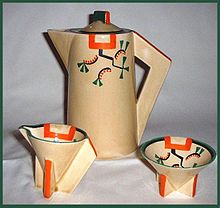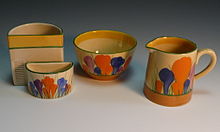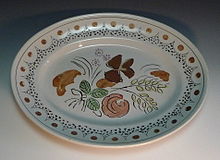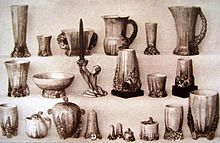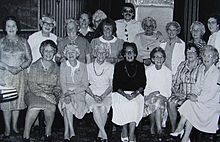- Clarice Cliff
-
Clarice Cliff (20 January 1899 - 23 October 1972) was an English ceramic industrial artist active from 1922 to 1963.
Cliff was born in Tunstall, Stoke-on-Trent, England.
Contents
Early life
The Cliff family ancestors moved to Tunstall, Stoke-on-Trent, Staffordshire from the Eccleshall area in about 1725. When Clarice was born their home was on Meir Street on a terrace of modest houses, but Tunstall was actually a slightly better part of Stoke on Trent. Cliff's father Harry worked at the local iron foundry in Tunstall, her mother Ann took in washing to supplement the family income, and they had 7 children.[1]
Cliff was sent to a different school to her siblings, and this perhaps prompted her more independent approach to her career, and her non-standard life style by Stoke on Trent standards. It is known that after school Cliff would visit aunts who were hand paintresses [2] at a local pottery company, and she also made models from papier-mâché at school.[3]
The size of the family meant that in 1899 the Cliffs moved to a larger home on the adjoining Edward's Street, where, as the children left school (aged 13), they were able to augment the family income, so they never suffered the intense hardships that affected many in the Potteries due to the high unemployment. School & Career At the age of 13, Cliff started working in the pottery industry. Her first work was as a gilder, adding gold lines on ware of traditional design. Once she had mastered this she changed jobs to learn freehand painting at another potbank,[4] at the same time studying art and sculpture at the Burslem School of Art in the evenings.
In 1916, Cliff made the rather unusual decision to move to factory of A.J. Wilkinson at Newport, Burslem, to improve her career opportunities. This necessitated a lengthy journey to work. This was an unusual start to an unusual career; most young women in the Staffordshire Potteries were on 'apprentice wages', and having mastered a particular task, stayed with that to maximise their income. However, Cliff was ambitious and acquired skills in modelling figurines and vases, gilding, keeping pattern books and hand painting ware: outlining, enamelling (filling in colours within the outline) and banding (the radial bands on plates or vessels). In the early 1920s her immediate boss Jack Walker brought Cliff to the attention of one of the two factory owners, Colley Shorter, who managed it with his brother Guy. Colley Shorter was 17 years older than Cliff, and as well as playing a major role in nurturing her skills and ideas, he was later to be her husband.
Cliff was given a second apprenticeship at A. J. Wilkinson's in 1924 (when she was already 25 years old) primarily as a 'modeller' but she also worked with the factory designers John Butler and Fred Ridgway. They produced conservative, Victorian style ware - Butler had been the designer for over 20 years by this time.[5] Eventually, Cliff's wide range of skills were recognised and in 1927 she was given her own studio at the adjoining Newport Pottery which Shorter had bought in 1920. Here Cliff was allowed to decorate some of the old defective 'glost' (white) ware in her own freehand patterns. For these she used on-glaze enamel colours, which enabled a brighter palette than underglaze colours.
She covered the imperfections in simple patterns of triangles, in a style that she called 'Bizarre'. The earliest examples had just a hand-painted mark, usually in a rust coloured paint, 'Bizarre by Clarice Cliff', sometimes with 'Newport Pottery' underneath. To the surprise of the company's senior salesman Ewart Oakes, when he took a car load to a major stockist, it was immediately popular. Clarice was given a young paintress Gladys Scarlett to help her with the ware, and soon a more professional 'backstamp' was made, which carried Cliff's facsimile signature, and proclaimed Hand painted Bizarre by Clarice Cliff, Newport Pottery England.
This backstamp was in fact to lead to Bizarre being used as an umbrella name for her entire pattern range, so that the factory then had to refer to the first pieces in the simple triangles as Original Bizarre.
In March 1927 Colley Shorter (who acted very independently of his brother, Guy), sent Cliff to the Royal College of Art in Kensington, London for two brief periods of study in March and May. These dates are recorded in the Royal College of Art archive and were also remembered by Gladys Scarlett (in 1982 [6] ) as she was briefly left alone at Newport to paint the new 'Bizarre' ware.
From 1927 Cliff was actually credited for shapes she designed, such as her Viking Boat flower holder, though her modelling for the factory is recorded in trade journal as far back as 1923-24. The shapes from 1929 onwards took on a more 'Moderne' influence, often angular and geometric, and some are what was to be later termed Art Deco. Abstract and cubist patterns appeared on these shapes, such as the 1929 Ravel (seen on Cliff's Conical shape ware) which was an abstract leaf and flower pattern named after the composer. The image shows a Conical coffee pot, and sugar bowl and cream with four triangular feet, another of Cliff's rather Bizarre shape ideas which proved popular with 1930s customers. Ravel was to be produced between 1929 and at least as late as 1935.
In 1928 Clarice produced a simple, hand painted pattern of Crocus flowers in orange, blue and purple, each flower being constructed with confident upward strokes. Then green leaves were added by holding the piece upside down and painting thin lines amongst the flowers. Being made from the individual brushstrokes, the Crocus pattern was clearly completely hand-painted, and the vibrant colours instantly attracted large sales.[7]
Initially, Clarice had just one young decorator produce Crocus, Ethel Barrow. But as orders flooded in by 1930 a separate decorating 'shop' was established underneath the top floor of the building which housed the 'Bizarre' shop, and Ethel became responsible for training young paintresses how to do the pattern. Twenty young women painted nothing but Crocus 5½ days a week, for much of the 1930s. Crocus was unusual in that it was produced on both tableware, tea and coffeeware, and 'fancies', novelty items made primarily as gift ware. The pattern had many colour variations, including Purple Crocus (1932) Blue Crocus (1935), Sungleam Crocus (1935) Spring Crocus. It was even produced after the war, the final pieces with Clarice Cliff marks being made in 1963, though Midwinter (who bought the factory) continued to paint it to order until as late as 1968.[8]
By 1929, Cliff's team of decorators had grown to a team of around 70 young painters, mainly women (called her 'Bizarre girls') but also four boys - who hand painted the ware under her direction. Many of these workers were traced in the 1980s and 1990s and they totalled over 100. Their names and work for Clarice Cliff was recorded in the centenary book.[9]
The factory produced a series of small colour printed leaflets (quite unusual for this time) which could be obtained by post, or picked up from stockists. This promotional device was clearly successful, as one young girl was employed whose only job was to put the leaflets in stamped addressed envelopes sent into the factory. At this time, many women would buy pottery by 'mail order' from advertising in magazines. The series of leaflets, each of which covered a range of pieces in a similar style or set of colours, included ones for Bizarre, Fantasque, Delecia, Appliqué, Inspiration, Crocus & Gayday and others. The original leaflet for the Appliqué patterns featured just two, Lucerne and Lugano , but Cliff's prolific ability to design new patterns is witnessed by the fact that by 1932 the Appliqué range had 14 patterns [10]: with Avignon, Windmill, Red Tree, Idyll, Palermo, Blossom, Caravan, Bird of Paradise, Etna, Garden, Eden and Monsoon in addition to the original two. The Appliqué Lugano pattern is shown left on a 10-inch (250 mm) wall plaque, with (inset) the printed Bizarre mark, and a hand painted range name as often seen on this ware. Appliqué, with its more intense colouring, proved long term to be one of the most sought after Cliff ranges.
The Fantasque range evolved between 1928 and 1934 and mainly featured abstracts or landscapes of cottages and trees, and some Art Deco inspired patterns. The first Fantasque landscape pattern was Trees and House and this sold well from 1930 until at least 1934. However, it was the slightly later, more sophisticated Autumn pattern issued near the end of 1930 which was to prove the most adaptable and popular. Originally created in red (coral) green and black in 1930, from 1931 many colourway variations appeared. The rarest remains the red colourway, shown on a 13-inch (330 mm) wall plaque, but the best selling version at the time was one with the trees in blue green and yellow. All these variations have proven particularly collectible.
In 1930, Cliff was appointed Art Director to Newport Pottery and A. J. Wilkinson, the two adjoining factories that produced her wares. Her work involved spending more time with the Colley Shorter, and this gradually developed into an affair, conducted in secrecy. The couple worked closely together on creating awareness of 'Bizarre ware' to catch the attention of buyers in the middle of a major financial depression, and with a skilful eye and great foresight, Colley Shorter registered Clarice's name and even some of her shapes. It was her ability to design both patterns and also the shapes they were to go on that distinguished Cliff above any other designers in the Staffordshire Potteries at this time. Her first modelling in the mid 20s was of stylised figures, people, ducks, the floral embossed Davenport ware of 1925. But in 1929 at the same time as she started the colourful cubist and landscape designs, Cliff's modelling took on a new style. This was influenced by European originals by Désny, Tétard Freres, Josef Hoffmann and others, that she had seen in design journals including 'Mobilier e Décoration'.[11]
Between 1929 and 1935 Cliff issued a mass of shape ranges, including Conical, Bon Jour/Biarritz, Stamford, Eton, Daffodil, and Trieste. In each of these there were tea and coffee ware shapes, but the first two were so popular that biscuit barrels, sugar sifters, bowls and vases were issued to enlarge the range. Bon Jour had 20 shapes created during 1933,[12] with about 10 more being added in 1934. There were also many other innovatively shaped vases, bowls and 'fancies', such as the Liner vase, Flower tube vase and the (now rare) Lido Lady ashtray and Age of Jazz musicians and dancers.
Through the depths of the Depression Cliff's wares continued to sell in volume at what were high prices for the time. Her Bizarre and Fantasque ware was sold throughout North America, Australia, New Zealand, South Africa, but not in mainland Europe. In Britain many top London stores sold it, including Harrods. Some of the other London stockists have long since closed, but the list [13] is impressive: 'Maple & Co., Lawley's, Bon Marche, John Lewis Peter Robinson, Selfridges, John Barker & Co., Warring & Gillow and Gorringe's'. However, the extant order books of the period confirm that Bizarre ware was never sold at Woolworths as some have erroneously stated.
Further outrageous patterns, vividly coloured, such as Melon and Circle Tree appeared in 1930. Cliff devised many ways of marketing these; in-store painting demonstrations, for which Cliff chose just the prettiest of her paintresses and most famously she and Shorter had the idea to actually pay major 1930s celebrities to endorse the ware. This was done both in magazine articles and by appearances at large stores. The celebrities included 'actresses Adrienne Allen, Marion Lorne, Marie Tempest, the BBC presenter Christopher Stone, musical comedy star Bobby Howes '.[14] Even Sir Malcolm Campbell who had just broken the world land speed record appeared at a promotion at the First Avenue Hotel, London in 1930.
Cliff's worldwide impact was made clear by a story in the 'Pasadena Evening Post' in California. It pictured her with a five-foot-high 'horse' made entirely of Bizarre ware which had been made to promote the ware in Britain. It was in this article, that Cliff made what has become her most famous quote: Having a little fun at my work does not make me any less of an artist, and people who appreciate truly beautiful and original creations in pottery are not frightened by innocent tomfoolery [15]
Between 1932 and 1934 Cliff was the art director for a major project involving nearly 30 artists of the day (prompted by the Prince of Wales) to promote good design on tableware. The 'Artists in Industry' earthenware examples were produced under her direction, and the artists included such notable names as Duncan Grant, Paul Nash, Barbara Hepworth, Vanessa Bell, and Dame Laura Knight. The project 'Modern Art for the Table' was launched at Harrods London in October 1934 but received a mixed response from both the public and the press, though at the same time Cliff's own patterns and shapes were selling in large quantities around the world.[16]
Cliff's patterns are highly stylised and interpreted in strong colours, such as the 1933 Honolulu pattern. The trees are enamelled in red (coral) orange and yellow. Cliff produced a colourway variation on this by simply changing the trees to shades of blue and pink, and this was then called Rudyard after a local Staffordshire beauty spot.
Clarice Cliff's fame and success in the 1930s are hard to fully appreciate now, but at that time there was no such thing as 'career women'. The publicity she received in the national press was unprecedented. Research by a PhD student into the contemporary press between 1928 and 1936 found '360 articles about Cliff and her work were published in the trade press, women's magazines, national and local newspapers'. [17] This was put into context when he pointed out that in the same period, Susie Cooper, another Staffordshire ceramicist and designer, had 'fewer than 20 reviews, all bar one in the trade press' .
Despite all the publicity she received, Cliff was actually quite camera shy, and in most cases the images of her pottery were what dominated the women's magazine of the day. One picture which shows Cliff informally was taken when a South Africans stockist of her ware, from Werner Brothers, visited the factory on a buying trip. Cliff is seen with the 3 year old daughter and wife of the stockist. After the visit Cliff sent the daughter a present of a miniature child's tea set painted in her Honolulu pattern.[18]
In the mid 30s tastes changed and heavily modelled ware came into vogue. The My Garden series issued from 1934 onwards led the way, with small flowers modelled as a handle or base on more rounded shapes. These were fully painted in bright colours - the body of the ware was covered in thin colour washes - 'Verdant' was green, 'Sunrise' yellow and so on. The range included vases, bowls, jugs, a biscuit barrel, and proved very popular as gift ware. It was produced in more muted colours, right until the start of the war in 1939.
Other modelled shapes included the 1937 'Raffia' based on traditional basketware by Native Americans, decorated in a similar style to them with small blocks of colour. More popular was the heavily modelled Harvest ware, jugs and bowls modelled with corn and fruit. After the war this range was heavily marketed in North America (very patriotically) as England. This later modelled ware attracts relatively low prices at auction.
In 1940, after the death of Ann Shorter, Colley's wife, he married Cliff and she moved into his home Chetwynd House at Clayton, Staffordshire. This Arts and Crafts home had been designed in 1899 and was one of the earliest commissions of the British architects Parker and Unwin Barry Parker Raymond Unwin who were later heavily involved in the Welwyn Garden city project.[19]
During World War II only plain white pottery (utility ware) was permitted under wartime regulations, so Cliff assisted with management of the pottery but was not able to continue design work. Instead she concentrated her creative talents on gardening and the massive 4-acre (16,000 m2) garden at Chetwynd House became her shared passion with Shorter.
After the war, although Cliff was occasionally nostalgic for the 'Bizarre' years, as witnessed in personal letters to friends, she seemed to be realistic and accepted the commercial taste was for conservative ware. Clarice seemed to enjoy playing a lesser role at the factory, knowing that she could not recapture those crazy days of the thirties.[20] Much of the post ware production went to Australia, New Zealand or North America, where the taste was for formal ware in traditional English designs such as Tonquin [21] rather than the striking patterns and shapes that had established Cliff's reputation; thus she was never to return to creative work. The post-war ware has little value at auction.
A.J.Wilkinson and their Newport Pottery continued to sell ware under Cliff's name until the death of Colley Shorter in 1963 led Cliff to sell the factory in 1964 to Midwinter and she retired becoming somewhat of a recluse. However, from December 1971 to January 1972, the first exhibition of Clarice Cliff pottery took place at Brighton, East Sussex. Cliff reluctantly provided comments for the catalogue, though she refused an invitation to go to the opening. The exhibition was prompted by enthusiastic collectors, including Martin Battersby, an early devotee of 20s and 30s design, the first author on that period to publish major works,[22] and a devotee of Cliff's ceramics. Then, on October 23 Cliff died suddenly at Chetwynd House. The exhibition and the first book published privately in 1976 'Clarice Cliff' by Peter Wentworth-Sheilds and Kay Johnson (L'Odeon publishing) marked the start of a major revival of interest in Cliff's work, which has continued to be sought after by Art Deco ceramic collectors ever since.
In 1982 the ORIGINAL Clarice Cliff Collectors Club was formed and promoted her and her work throughout the world. The club founder had appealed in the Staffordshire Evening Sentinel for anyone who worked with Cliff to contact him and was delighted when he found 28 former workers. Still calling themselves the 'Bizarre girls' even in their mid 70s and early 80s Cliff's former paintresses were delighted in the interest in the pottery they had hand painted 50 years earlier. They attended the annual meetings of the club, and were to be involved in many television and radio programmes about Cliff, and a mass of books that appeared. Many of their memories were recorded in the CCCC Reviews from 1982 to 2004. The club also held meetings and exhibitions in Britain, North America, Australia and New Zealand.
The Stoke on Trent meetings visited the old painting shop of Bizarre ware by the canal at Newport, Burslem from 1987 to 1997, ironically the only building left standing on the site.[23] Sadly it was demolished by Wedgwood in 1997, and the land sold for housing.
A chain of mergers had led to Wedgwood owning the Clarice Cliff name, and from 1992 to 2002 they produced a range of reproductions of the highly sought 1930s pieces. These were made to a high quality, and were produced in small numbers for sale to collectors who could not find (or perhaps could not afford) the most striking original pieces.
The first pieces produced included a ginger jar in House and Bridge, a large shape 14 vase in Solitude, a Stamford shape teapot milk and sugar in Pink Roof Cottage, a Conical bowl in Tennis, and a wall plaque in Lightning. From 1996 to 2002 pieces were made for CCCC members and these were also sold at major Wedgwood rooms. The hand painted pieces ceased production in 2002 but ware with printed (not hand painted) patterns were made in larger quantities by Wedgwood during and after this time. These reproductions should not be confused with forgeries (of which a number are found), the Wedgwood ones are clearly marked as 'Wedgwood Clarice Cliff'. An original Cliff paintress Alice Andrews, then in her 80s, was employed to appear at launches of the ware in stores throughout Britain.[24]
In the mid 90s Cliff's position as a major artist of her era was confirmed when she was included in major international reference works; the massive Dictionary of Art by Macmillan Publishers, and Allgemeines Künstlerlexikon by K. G. Saur Verlag .[25]
The work of the CCCC culminated with the centenary exhibition 'Clarice Cliff the Art of Bizarre' at the Wedgwood Museum, Barlaston Stoke on Trent. Nowadays, with 26 years of experience the club is based on the internet (see below). It should not be confused with an organisation who used the same name from 2001 after registering it in 1997. The CCCC was then the consultant for the BBC Radio 4 drama 'The Bizarre Girl', written by Lizzie Slater which was described as 'an uplifting drama exploring the dramatic rise of Clarice Cliff from the shop floor to Company Art Director ~ illustrating how a working-class Staffordshire girl brought modern art to the people'. The drama was broadcast in December 2000.[26]
In 2002 Peter Wentworth-Sheilds and Kay Johnson, the authors of the original 'Clarice Cliff' book from 1976 returned to Britain to lecture at a CCCC event at Christie's, South Kensington. They spoke about the early days of collecting when their first purchase had been, 'a Summerhouse Athens jug for 7 shillings and 6 pence, 35 pence'. [27] Peter had actually spoken to Cliff on the phone, but she had declined to be interviewed. They revealed that they had both been working for Stanley Kubrick when they wrote their book; Kay was Kubrick's personal assistant, and as set designer Peter had been able to decorate a room in A Clockwork Orange with a frieze he has designed based on original landscapes by Cliff.
The collecting market for Clarice Cliff pottery is complex; it is still possible to find examples of Crocus, Cliff's longest produced pattern (1928–1964) for as little as £30-50. But rare combinations of shape and pattern attract very high prices at auction. The world record price for a piece of Clarice Cliff is held by Christie's, South Kensington, London, who sold an 18-inch (460 mm) 'charger' (wall plaque) in the May Avenue pattern [28] for £39,500 in 2004. Shortly after this the same auction house sold an 8-inch (200 mm) vase in Sunspots for £20,000.[29]
In 2008, Cliff's pottery continued to prove both sought after and esteemed. Despite the financial depression collectors still paid high prices for special pieces. In Britain, Bonhams, London sold a 'Triple Bonjour' vase in Blue Firs for £6000.
A rare Red Autumn shape 369 vase sold for £4900 at Fielding's auctioneers, Stourbridge in the West Midlands, and Woolley and Wallis auctioneers Salisbury sold a 3-inch (76 mm) high miniature vase in Café (used as a salesman's sample in the 1930s) for a staggering £3000.[30] In May 2009 an eighteen inch charger in the May Avenue pattern sold for £20,500 at Fielding's auctioneers. [31]
On 2 August 2009 Will Farmer of the BBC Antiques Roadshow and members of the original Clarice Cliff Collectors Club unveiled three plaques commemorating Clarice Cliff's life and work in the Potteries.
These were on her birthplace, Meir Street, Tunstall, her second home on Edwards Street, Tunstall and the site of Newport Pottery by the canal in Burslem where her Bizarre ware was decorated. These were filmed by BBC television for showing on a special Antiques Roadshow programme in December 2009.[32]
In September 2009 the Victoria and Albert Museum in London opened its 'New Ceramics Galleries' and Cliff's work was chosen to be included; 'There will be two rooms displaying 20th-century collections. One will show ceramics made in a factory context and will include objects by designers such as Susie Cooper and Clarice Cliff' .[33]
See also
- Susie Cooper
- Charlotte Rhead
- Keith Murray, Ceramic artist
References
- ^ Wentworth-Sheilds Peter, Johnson Kay: Clarice Cliff, L'Odeon publishing 1976/1981
- ^ The decorating shops in many Staffordshire factories were in this era almost totally staffed by women on 7 year 'apprenticeships' who were called hand paintresses. They produced top quality work at an apprentice price which gave them job security. The term is still correct in Staffordshire, though the art of hand painting onto ware is now rarely seen commercially
- ^ Wentworth-Sheilds Peter, Johnson Kay: Clarice Cliff, L'Odeon publishing 1976/1981
- ^ A Staffordshire term for a pottery factory, probably because they had a 'bank' of clay for making the 'pots'
- ^ Griffin Leonard, Meisel Louis and Susan: Clarice Cliff the Bizarre Affair Thames & Hudson London / Abrams New York 1988/1995
- ^ Griffin Leonard: an interview with Gladys Scarlett in 'The Clarice Cliff Collectors Club Review magazine'
- ^ Griffin Leonard: The Fantastic Flowers of Clarice Cliff Pavilion/Chrysalis 1998/2001
- ^ Slater Greg, Brough Jonathan: Comprehensively Clarice Cliff: Thames and Hudson 2005
- ^ Griffin Leonard: Clarice Cliff the Art of the Bizarre Pavilion/Chrysalis 1999/2002
- ^ Griffin Leonard: The Complete Book of Appliqué 1989/1994 published privately by the original Clarice Cliff Collectors Club
- ^ Griffin Leonard: Clarice Cliff the Art of the Bizarre (chapter 'Dramatic Art Deco') Pavilion/Chrysalis 1999/2002
- ^ For Bon Jour range illustration see p.53: Griffin Leonard, Meisel Louis and Susan: Clarice Cliff the Bizarre Affair Thames & Hudson London/Abrams New York 1988/1995
- ^ Knight Lynn: p.167 Clarice Cliff biography Bloomsbury Press 2005
- ^ Knight Lynn: Clarice Cliff biography Bloomsbury Press 2005
- ^ 'Pasadena Evening Post' story 1931
- ^ Griffin Leonard: Clarice Cliff the Art of the Bizarre (chapter Bizarre meets Bloomsbury) Pavilion/Chrysalis 1999/2002
- ^ Woodward Dr. Philip: writing in: 'The Bizarre Art of Clarice Cliff' (Pavilion/Chrysalis 1999/2001)
- ^ Griffin Leonard: Taking Tea with Clarice Cliff (Pavilion/Chrysalis 1996/2002
- ^ Griffin Leonard Clarice Cliff: The Fantastic Flowers of Clarice Cliff Pavilion/Chrysalis 1998/2001
- ^ Doreen Mann (nee Jenkins) writing in Fantastic Flowers of Clarice Cliff Pavilion/Chrysalis 1998
- ^ Slater Greg, Brough Jonathan: p. 266 Comprehensively Clarice Cliff: Thames and Hudson 2005
- ^ Battersby Martin: The Decorative Thirties Studio Vista publishing 1969/1976
- ^ The 'Review' magazine of the Clarice Cliff Collectors Club: 1997
- ^ The Original CCCC Review magazine 1992–1999
- ^ Allgemeines Künstlerlexikon: K. G. Saur Verlag 1998, Germany. Dictionary of Art: Macmillan, London 1996
- ^ The Original CCCC 'Newsletter' October 2000
- ^ Original CCCCC 'Review' magazine - Summer 2002
- ^ Guatelli Sevi, Griffin Leonard: p. 264 (for a similar example) The Best of Clarice Cliff Best 50 publishers 2008
- ^ Guatelli Sevi, Griffin Leonard: p. 183 The Best of Clarice Cliff Best 50 publishers 2008
- ^ Various: auction reports on www.claricecliff.com in 2008.
- ^ Catalogue, 'CCCC sale No. 3' on 30 May 2009, at Fieldings of Stourbridge
- ^ Stoke-on-Trent Sentinel - 3 August 2009 and reports on www.claricecliff.com.
- ^ Victoria and Albert Museum, press release by Meera Hindocha, 17 September 2009
External links
- The Original Clarice Cliff Collectors Club Founded 1982. Registered under the Business Names Registration Act 1982. No. 2803197
- Stoke-on-Trent Museums See Clarice Cliff's designs, plus the World's Finest Collection of Staffordshire Ceramics at The Potteries Museum & Art Gallery.
Categories:- 1899 births
- 1972 deaths
- English artists
- Modern artists
- English potters
- Art Deco designers
- People from Tunstall, Staffordshire
- People from Stoke-on-Trent
Wikimedia Foundation. 2010.



